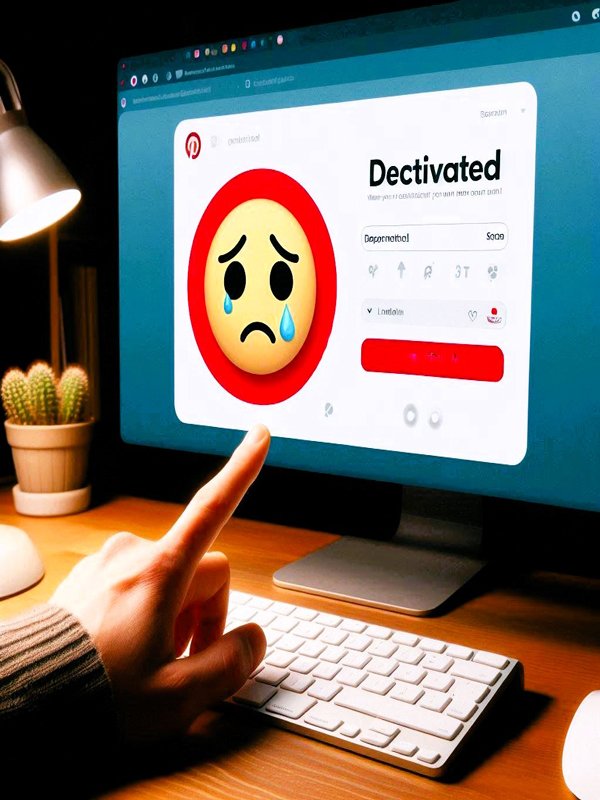On day 84 of my blogging career, my Pinterest account was deactivated. Goodbye, Pinterest traffic! It turns out my account was deactivated for violating Pinterest spam policies. But what exactly did I do wrong? Let’s dive into the details.
Signs Your Pinterest Account is Deactivated
When your Pinterest account gets deactivated, you’ll be logged out unexpectedly. When you try to log back in, you’ll see a message stating that your account has been deactivated due to a violation of Pinterest’s policies. You will also receive a brief, vague email from Pinterest explaining the reason for the deactivation (see Picture 1).

My Method for Tagging Products on Pinterest
I wanted to share my method for tagging products in my Pins, hoping it might be helpful for others. When creating a new organic Pin, I upload an image or video, fill in the pin details, and click on “Add products” to the right of the Pin (see Picture 2).

From there, I select “Use a link” and provide my affiliate link (see Picture 3). The tagged products are then displayed below or to the side of the Pin.

I avoided direct linking in the “Link” section of the pin as I was concerned it might be considered bad practice and lead to account suspension (ah!)
Investigating the Cause of Deactivation
After my account was deactivated, I took several steps to understand why it happened and how to prevent it in the future. Here’s what I found:
Contact the Help Centre – You’d think reaching out to Pinterest’s Help Centre would solve all your problems, right? Think again! I emailed them three times asking for a more detailed reason for my account suspension, and each time, I received the same generic elusive chatbot response. No luck getting through to a human. But don’t let my experience deter you—give it a try; you might have better luck.
Refer to the Guidelines – Left to my own devices, I turned to Pinterest guidelines on spam. As I re-read them, a twinge of guilt crept in. My pin scheduling strategy could have easily been seen as spamming according to their rules. Yet, this method is widely recommended by Pinterest gurus: repurpose the same content with different images and descriptions. Surely, it couldn’t be that; if it were, most business accounts would be deactivated by now. Plus, I had been doing this for weeks without any issues.
Ask the net – I scoured Google and YouTube for answers but found little useful information. One common cause for account suspension related to spam seems to be the frequency of using the same URL per day. However, there is no official figure for this limit, and no one seems to know the exact number. On the day my account was deactivated, I used the same URL twice on two separate pins for the first time. Could that be it? It seemed extreme, especially since I’ve seen some accounts use the same URL multiple times a day.
Retrace your steps – I reviewed my recent activity and recalled creating a Pin and trying to tag products, just as I had successfully done before (as described here). But this time, the last product tag wouldn’t work. I generated a new link, but still nothing. I frantically tried different products, but each attempt failed. Then, suddenly, I was logged off. When I tried to log back in, my account was deactivated. This gave me a clue: I checked Pinterest policy on tagging products and discovered there is a maximum of 24 products per account. The last item that wouldn’t tag was number 25! Mystery solved: Pinterest allows tagging up to 24 products per account; exceeding this limit triggers a spam activity flag.
Lessons Learned
Despite my efforts to appeal, I was unable to get my account reactivated. So, it’s definitely worth considering these key takeaways to avoid account deactivation in the future.
- When tagging products on Pinterest, it’s important to stay within the platform limits. Pinterest allows you to tag up to 24 products per account. If you exceed this limit, you risk your account being flagged for spam.
- To tag products correctly, follow the steps on the Pinterest guidance, ensure each tag is relevant to the pin, and avoid tagging the same product multiple times in different pins.
- Additionally, consider using other strategies to link product such as through your blog or a Shopify store. You can then promote these on Pinterest to drive more traffic.
If you’re interested in learning more about my experiences and challenges as a DIY blogger, or if you have any questions, please leave a comment below. Also, feel free to share your own experiences and tips! If want to know more about me and my background, visit my About page.
Alla prossima!

